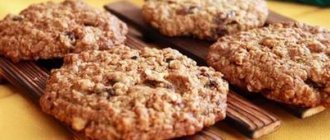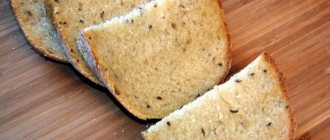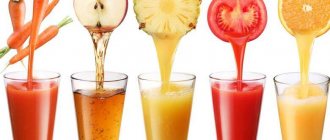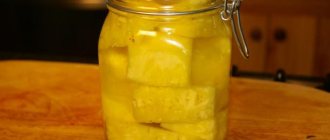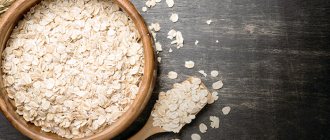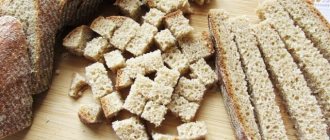- Why do you need a diet for autism?
- How to eat with autism
- Gluten-free diet for autism
- Casein-free diet for autism
- Adapted Ketogenic Diet
- Low oxalate diet
- Diet for autism in children
- Sample menu
Today, autism is an extremely common problem, and therefore new methods for diagnosing and treating this condition are regularly developed and tested.
Of the variety of therapeutic methods used to correct autism spectrum disorders, only the applied behavior analysis (ABA) method so far has the status of scientifically grounded and officially recommended. But still, when putting the mental level in order with the help of ABA therapy, one should not forget about the physical level - and here the correct diet for autism comes in handy, the main varieties of which we will describe in detail in this article.
About Autism
Before we directly move on to figuring out where to start with the BGBK diet, we need to find out exactly how autism affects the human body. As mentioned earlier, children with autism cannot digest gluten and casein normally, so after eating foods containing them, these proteins enter the bloodstream as endorphins. Their effect on sick bodies is quite similar to narcotic substances, and therefore autistic people cannot fully perceive reality and behave quite strangely. It is because of the incorrect BCBG diet for autistic people that people think that they are very strange and begin to antagonize patients and are not accepted in society. It is extremely important that such people adhere to proper nutrition throughout their lives, starting from infancy and even in kindergarten. It has long been observed that those patients who adhere to the special GBK diet for autism show noticeable improvements in their neurological condition after some time.
Gluten Free Products
There are manufacturers of flour, pasta and gluten-free bakery products in the world and in Russia. The manufacturer is obliged to make a note about this in English or Russian, or to apply the symbol of a crossed out spikelet. A lactose-free product must have the symbol of a crossed out milk carton.
Often the label “gluten free” means that its content is less than 20 mg per kg of product. Since 2013, it has been established that this level is acceptable for patients.
If you doubt the presence of a dangerous ingredient, test at home with iodine tincture. Gluten will produce a dark purple stain. You can purchase the necessary products in specialized stores. The available range can be ordered online.
Diet principles

Scientists have noticed that an incorrect diet in autism leads to the human body being in a state of intoxication due to two indigestible proteins. The inappropriate behavior of such people can be explained by the fact that such toxins begin to cause degradation processes in the brain. That is why for those who are wondering where to start with the BGBK diet, you should know that you need to completely remove from your diet all those products that contain gluten and casein, that is, wheat, barley, bread and almost all baked goods, as well as milk and everything made from him products. Proper nutrition here needs to be varied with a large amount of protein, as well as diversify it as much as possible with a full range of vitamins and other nutrients.
Fats on a similar GBK diet for autism also need to be severely limited, with preference given to vegetable oil and butter. Complex carbohydrates do not need to be limited at all - as long as they do not contain gluten, they will be healthy. It is also advisable to limit the amount of salt consumed, and steam or simply boil all dishes, since this method of preparation, according to reviews, is most suitable for autistic people on the GGBK diet.
How to eat with autism
Most autistic people limit their diet on their own, giving up many healthy foods in favor of food that is essentially useless - pasta, baked goods, pizza, ice cream, etc. That is, precisely those foods that contain a lot of gluten, casein, sugar, starch, and various allergens, preservatives, flavors and other undesirable substances. This fact naturally leads supporters of diet therapy to the idea that autistic people are in a kind of “narcotic” dependence on these substances. But, of course, the causes of autism in children cannot be explained simply by food preferences.
In some cases, people diagnosed with autism prefer to eat only foods of a certain color, which further complicates food problems.
The task of parents or guardians of an autistic person is to provide him with a nutritious diet with a balanced vitamin and mineral composition. Of course, there may be certain difficulties along this path, because the introduction of new products to the menu and the refusal of familiar food can provoke a protest from the ward. However, over time, the situation will definitely improve, especially with the right approach to changing the diet, which should occur according to the following rules:
- you need to add new products to the menu and exclude old ones in stages;
- If possible, try to choose new products that visually resemble old ones;
- elements of the game can and should be included in the process of switching to a new diet;
- It is worth warning relatives and friends not to bring unwanted products when visiting you.
It will be much faster and easier to achieve good results if the rest of the family members also adhere to the new diet - then the ward will not be tempted to find and eat something harmful to himself.
It should be immediately clarified that the number of permitted products significantly exceeds the number of prohibited ones, so the taste preferences of an autistic person in most cases change quite quickly.
What can you eat if you have autism?
If autism is diagnosed, it is recommended to plan your diet based on:
- a lot of vegetables. Eating cauliflower, eggplant, zucchini, cucumbers, green beans, lettuce, pumpkin, carrots, onions and leeks is especially beneficial;
- gluten-free cereals (rice, buckwheat, sago, millet/millet, amaranth, quinoa, sorghum);
- fruits (grapes, plums, pears, apricots, peaches) - you can also make juices, fruit purees, homemade jam with fructose instead of sugar from them;
- meat (lean pork, chicken, turkey, rabbit, nutria and other dietary meats);
- fish (preferably small ones - sprat, herring, herring, sardines, mackerel).
To season dishes, you can use vegetable margarine, olive and sunflower oils, as well as walnut, pumpkin, hemp, grape seed, and vinegar (high-quality wine, apple or rice). The consumption of various greens, honey, dried fruits, and raisins is allowed.
It is advisable to drink a sufficient amount of purified and moderately mineralized water, alternating these two types.
It is very useful to add ground flaxseed or psyllium seeds to your food (1-2 tablespoons per day), as well as dietary fiber from gluten-free crops.
Such a menu can quickly minimize the allergenic and toxic load on the body of an autistic person, which will also have a beneficial effect on his mental health.
What can't you eat if you have autism?
The prohibition of certain foods in autism largely depends on the type of diet chosen. Thus, a gluten-free diet involves avoiding wheat, barley, some cereals, bread and other products containing gluten. If, in addition to a gluten-free diet or separately from it, a casein-free diet is practiced, then the consumption of animal milk, the bulk of dairy products, as well as soy in any form will be prohibited. We will talk in more detail about the HD and CD diets below.
Regardless of the presence or absence of a diet, you should refrain from consuming foods containing the following substances:
- sugar and synthetic sweeteners (which is why drinking sugary carbonated drinks is strongly discouraged for people with autism);
- artificial preservatives and colorants (dyes);
- harmful “E-substances” – some food additives with the letter “E” in the name. Lists of harmful and harmless additives in this category can be found online.
You should be careful with products such as:
- starchy vegetables (potatoes, peas, lentils, beans) - they are best consumed infrequently and in small quantities, constantly monitoring the body's reaction;
- beef - this meat often causes allergies, and in addition, beef proteins are similar in composition to dairy, which is why beef meat is not recommended for a casein-free diet;
- large fish (especially tuna) can be dangerous due to the high risk of containing mercury;
- any fish caught in the Baltic Sea is conditionally dangerous due to the possible content of dioxins - harmful synthetic substances that accumulate in living tissues;
- eggs (except quail), as well as some vegetables and fruits, can cause allergies in some cases. Therefore, when planning a menu for an autistic person, it is necessary to carefully monitor his body’s reaction to citrus fruits, tomatoes, mushrooms, peanuts and other nuts, bananas, and apples.
Store-bought sausages, frankfurters, and processed meats deserve special mention - they often contain milk and/or wheat flour, so it is prohibited to include them in the menu of autistic people following a gluten-free and/or casein-free diet. Also, people who suffer from autism are not recommended to eat foods with high levels of soda and/or phosphates.
BGBK Diet Recipes
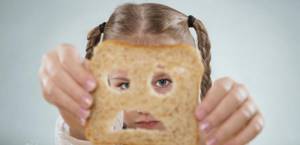
Even though this diet for autism has a large number of limited foods, since flour and dairy products are prohibited, this does not mean that it is impossible to prepare some interesting dishes. Such a diet, if you have enough imagination, can be very multifaceted, and the diet can be as varied as possible. Below are some recipes for autistic people on the BGBK diet.
List of approved products
After reviewing the list of permitted foods, it is easy to understand that no one will go hungry.
- any vegetables;
- fruits and berries;
- mushrooms;
- nuts;
- vegetable oils;
- cereals - buckwheat, corn, sorghum, millet, rice;
- eggs;
- flour - corn, buckwheat, amaranth, rice, nut, lentil;
- legumes;
- natural seasonings and spices, grape vinegar;
- natural milk and dairy products;
- cheese, feta cheese;
- meat, poultry, excluding duck and goose;
- fish, seafood;
- loose leaf tea, natural coffee;
- do-it-yourself blanks.

Easy 3 Ingredient Pancakes
Everyone knows that breakfast is one of the most important meals. This is also a must for autistic people, so you can make simple pancakes that are completely gluten-free.
Ingredients:
- 1 banana;
- a pair of eggs;
- a small amount of cinnamon to improve taste.
Preparing these pancakes is quite simple, the main thing is to have sweet and overripe bananas in the refrigerator. To create the dough, you need to mash the banana with a fork into a liquid puree, and then mix them with the eggs and beat until the mixture becomes homogeneous. Season with a little cinnamon and then start cooking. To do this, heat a frying pan over medium heat and coat it with a small amount of oil. Pour a small amount of batter into the center and then lightly spread around the pan. You need to cook the pancakes for a couple of minutes on each side. They turn out very soft and tasty.
Homemade Gluten Free Baking Recipes
Gluten free quick pancakes
Finally, we’ll tell you how to make thin homemade flatbreads or pancakes using starch. Based on them, you can prepare “nalistniki” - rolls or envelopes with any filling. Most often they are made with cottage cheese, potatoes with mushrooms, bean paste, toffee, and also served with jam or sour cream.
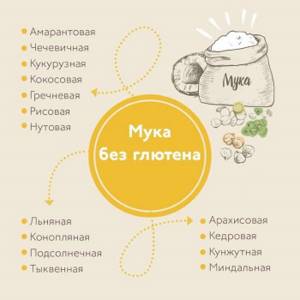
List of ingredients:
- starch – 5 tbsp;
- milk – 500 ml;
- eggs – 4 pcs.;
- salt and sugar - to taste;
- vegetable or butter for processing the pan and impregnation.
It is necessary to shake the eggs and gradually add the sifted starch, making sure that no lumps form. Salt the dough and add warm milk little by little, stirring the dough.
At the last stage, you can add sugar and vanilla to taste. Sometimes added to salty pancakes
- tomato paste,
- onion and garlic powder,
- chopped fresh herbs (such as dill or basil) or
- dried herbs.
Good to know: you can use half-and-half flour with starch.
Vegan flatbreads
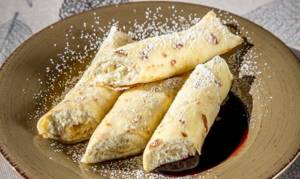
To make vegan flatbreads you need:
- water – 1 tbsp.;
- rice, almond or soy milk - 1 tbsp.;
- starch - to the desired consistency (from 4-5 tbsp);
- salt, sugar - to taste;
- soda - a quarter tsp. (optional, but needed for pancakes);
- vegetable oil - according to consumption for greasing the frying pan and finished pancakes.
Starch is diluted in milk, salt and sugar are added, and the dough is diluted with water until a very liquid consistency is formed. Pancakes are tenacious thanks to starch and do not tear.
The sheets are cooked in a wide, well-greased frying pan. The pancake quickly sets and dries, after which it needs to be masterfully flipped over. The finished sheets are greased with oil.
If you are wrapping a complex filling, I place the envelopes or rolls in a bowl and simmer for another 20-25 minutes in the oven under cream or tomato sauce.
This is useful: if you thicken such a dough. It will make fluffy pancakes, dumplings or dumplings.
Chicken taquitos
An interesting snack option would be chicken taquitos, which are perfect for this type of diet.
Ingredients:
- whole small chicken;
- poblano pepper;
- onion cut into pieces;
- 1 garlic;
- 30 corn tortillas;
- 1 teaspoon salt;
- 1 teaspoon cumin;
- oil for frying.
The first step to making taquitos is to prepare the chicken. To do this, rinse it thoroughly and place it whole in a saucepan with added salt. It will cook for about an hour - this time is quite enough for its preparation. After this, the chicken is removed from the water and cooled. All meat from the chicken must be removed and broken into small pieces.
The poblano peppers need to be blackened on the grill and then placed in a bowl for a quarter of an hour. This will help you easily remove the skin later. When the pepper has cooled, it must be completely cleared of the stem and seeds. After the cooked pepper is cut into small cubes. The onion, in turn, is cut into thin slices. It needs to be fried in a hot frying pan until it becomes soft and slightly caramelized. In a bowl, mix chicken, pepper, cumin, onion, garlic and salt.
After this, you need to start preparing the tortillas. To do this, they should be heated in a frying pan on both sides, and then immediately filled with filling, rolled up and pinned with a toothpick. For final preparation, taquitos need to be fried in oil until golden brown, seam side down. Serve this dish with salsa and guacamole sauce. These taquitos will be a truly Mexican holiday.
Gluten Free Vegetable Lasagna
To speed up the cooking process, it is recommended to boil the lentils in advance. You can also roast vegetables in the oven ahead of time.
What you will need:
- Fine corn grits (1 cup and a quarter)
- Chopped onion (1 cup)
- Garlic (2 cloves)
- Grated Parmesan (quarter cup)
- Sweet pepper (1 large or a couple of medium ones)
- Marinara sauce (3 cups)
- Chopped fresh oregano (2 tablespoons)
- Mozzarella (100 grams)
- Water (4 glasses)
- Chopped fresh basil (2 tablespoons)
- Fresh mushrooms (150 grams)
- Eggplant (1 large)
- Chopped fresh rosemary (quarter cup)
- Cooked lentils (100 grams)
- Olive oil (1 tablespoon)
- Salt, black pepper - to the taste of the cook.
Preparation:
- Boil water in a large saucepan. Slowly add corn grits in a thin stream. Boil for 10-12 minutes (until thickened), stirring frequently. During the process, add salt, pepper and add rosemary (if you don’t have fresh, dried in the amount of a tablespoon will do).
- Pour the resulting porridge into two molds (approximately 20x20 cm - optimal layer thickness 1 cm), carefully smooth the surface with a spatula. You can also place it in one large container, in which case the finished layer will have to be cut in half.
- When the polenta has cooled slightly, place the molds in the refrigerator.
- Wash the peppers and eggplant thoroughly. Pierce the latter with a fork in several places, place on a baking sheet and bake at 200 degrees until the skin is charred (about 40 minutes). Or, alternatively, brown it without oil on the grill. Ready to cut into two parts to extract and grind the pulp.
- Place the pepper in the oven too, but at a higher temperature: 220 degrees. As soon as it softens, remove, cool and remove the skin by placing under cold water. Chop the pulp, freed from seeds, into strips.
- Heat olive oil in a frying pan. Simmer the onions, mushrooms and finely chopped garlic together: covered, over medium heat, until the onions soften. Then keep it on the fire a little longer without a lid to evaporate excess liquid.
- Combine the contents of the pan, chopped vegetables and boiled lentils. Add chopped mozzarella and all the herbs (rosemary and basil can be dried, you will need less than a tablespoon of each).
- Turn the oven back on, setting the temperature to 180 degrees. Grease the bottom of the casserole dish with sauce (3/4 cup), place one of the layers of chilled corn porridge.
- Spread the mushroom, vegetable and cheese filling evenly over the polenta. Top with another batch of marinara, then place a second layer of corn on top.
- After pouring the remaining sauce, generously sprinkle the lasagna with parmesan shavings. Cover the pan with foil and place in a hot oven for half an hour. Cool the finished dish slightly before cutting into portions.
Asian chicken
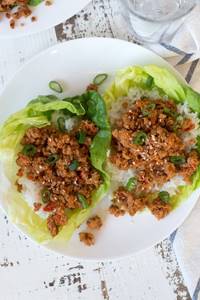
If you want to try interesting and exotic recipes, you can cook Asian chicken. The dish will contain meat and vegetables, and therefore there is absolutely no gluten or casein.
Ingredients:
- 800 grams of chicken fillet (if desired, you can replace it with turkey);
- 1 red bell pepper, cut into small cubes;
- a couple of carrots, grated on a medium grater;
- 2 cloves of garlic;
- 50 ml low sodium soy sauce;
- 50 ml tomato sauce;
- 1 tablespoon honey.
It is best to cook this chicken in a slow cooker, since in this way you can preserve a large amount of nutrients, and the dish itself will turn out very juicy. To prepare it, you will need to add vegetables and meat to the slow cooker and cook them for 4 hours until the chicken is incredibly soft. After this, the chicken should be broken into pieces. Everything is mixed with the sauce from the remaining ingredients so that the dish is thoroughly saturated with it. This dish is very convenient because it can be frozen without losing its taste. You can serve it with salad and rice as a side dish.
Gluten-free diet for a week for children

If a child is diagnosed with intolerance, the first step is to exclude all synthetic sauces, canned food and fast food - these are the foods that contain gluten.
The diet of children and adolescents should be filled with homemade food: pureed soups, dairy products (or calcium-rich equivalents) and safe cereals.
Particular attention is paid to sweets.
Sample meal plan for a week
Monday:
- Breakfast – a portion of cottage cheese, a glass of fresh juice, a white cracker.
- Lunch – green cream soup with vegetables and potatoes, cheese sandwich on a corn tortilla, tea.
- Afternoon snack – fruit bar, fresh fruit;
- Dinner – vegetable stew, yogurt, compote.
Tuesday:
- Breakfast – rice porridge with milk, green tea, apple.
- Lunch – light soup with millet, omelette with herbs / portion of tofu, mashed potatoes, marmalade or agar paste for dessert, any drinks.
- Afternoon snack – cheesecake or starchy cheesecakes with homemade jam or sour cream, compote.
- Dinner – smoothie with yogurt and fruit, white crackers.
Wednesday:
- Breakfast – boiled egg / portion of cheese or tofu, corn porridge, peach, tea.
- Lunch – broth, chicken fillet / portion of chickpeas in a delicate creamy sauce, steamed vegetables (mild spices can be used), tea or juice, toffee for dessert.
- Afternoon snack – nut kozinaki or dried fruits.
- Dinner – yogurt with herbs, eco-marshmallows.
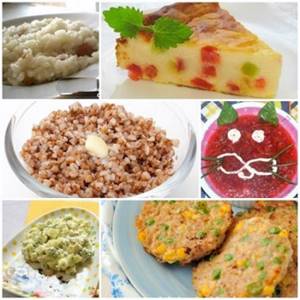
Thursday:
- Breakfast – corn pancakes with cottage cheese, fruit, tea.
- Lunch - broth, stewed vegetables with meat or beans (for example, in tomato), any safe sweets for dessert.
- Afternoon snack – yogurt, rice cake with butter.
- Dinner – fruit smoothie.
Friday:
- Breakfast – cream soup with carrots and corn (you can add chicken/peas), fruit bar, compote or tea.
- Lunch – vegetable salad, a portion of cottage cheese, rice balls fried in oil, compote.
- Afternoon snack – banana, gluten-free chocolate milk or caramel dessert (starch pudding, ice cream).
- Dinner – scrambled eggs or bread with tofu.
Saturday:
- Breakfast – rice with vegetables, omelette or red beans, fruit bar, tea.
- Lunch – fish/mushroom soup, potato stew with green beans and vegetables, jelly, compote.
- Afternoon snack – glazed cheese / portion of peanuts, fruit.
- Dinner – a glass of kefir with honey, white cookies.
Sunday:
- Breakfast – milk and fruit smoothie, grilled cheese or tofu with vegetables, tea.
- Lunch - borscht (with meat, beans or mushrooms), vegetable cutlets (carrot, zucchini or cabbage - with starch), marmalade or fruit, tea.
- Afternoon snack – starch cookies or pudding, maybe with chocolate, banana, a glass of milk.
- Dinner – rice with milk and berries, tea.
Chocolate coconut pudding

Recipes for children on the BGBK diet are very important, since a small child needs to be pampered with something tasty from time to time. One such healthy dessert can be chocolate coconut pudding. It is quite simple to prepare, since it consists of only 4 ingredients and does not contain any milk.
Ingredients:
- coconut milk - 400 ml;
- gelatin - half a tablespoon;
- dark chocolate - 100 g;
- vanilla extract - 1/2 teaspoon.
To create a delicious pudding, the first step is to dissolve the gelatin in a small bowl. To do this, mix it with a tablespoon of coconut milk and mix everything. The gelatin will dissolve in about 5 minutes. This step is the most important - if the gelatin does not dissolve correctly, then the pudding will not acquire the desired consistency.
The second step is to heat the coconut milk in a saucepan over medium heat. Do not allow it to boil, however, the gelatin must completely dissolve. After this, chocolate is added, and while it is melting, you need to constantly whisk the mixture. Once all the chocolate and gelatin have dissolved and the mixture is sufficiently whipped, add vanilla extract and turn off the heat. The resulting mixture is poured into molds and placed in the refrigerator. After about two hours, the pudding will be firm and ready to serve.
Gluten-free diet for a week for active people
Anyone who works hard or loves nutritious meals needs a satisfying menu. In such a diet, the proportion of carbohydrates is increased, not forgetting the increase in proteins and fats. Athletes can focus on protein products. We offer a sample of a dense gluten-free menu for the week.
Monday
- Breakfast - smoothie with fruit and honey on yogurt, scrambled eggs or grilled cheese (tofu can be used), sweet coffee.
- Lunch – borscht with meat or beans, potatoes with vegetables in a pot, tea with white biscuits.
- Afternoon snack – a glass of milk or tea with a white bar.
- Dinner – julienne with squid or mushrooms (the basket is made with starch), tea, maybe fruit alcohol.
Tuesday
- Breakfast – chia jelly or rice pudding with fruits and nuts, boiled egg / slice of cheese / tofu, coffee.
- Lunch – chicken or pea cream soup, baked fish / mushrooms and rice with vegetables, tea, dried fruits.
- Afternoon snack – white biscuits.
- Dinner – smoothie with sour milk with any filling (un/g).
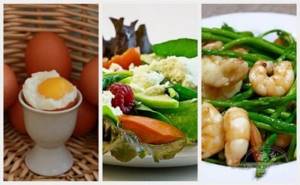
Wednesday
- Breakfast - omelette or avocado cream with rice porridge, rice bread with cheese / tofu, tea or coffee.
- Lunch - funchoza noodle soup (starch) - chicken or mushroom, steak / soy goulash with potatoes and vegetables, tea, homemade kozinaki (you need to check the labeling on all finished products - noodles, soy).
- Afternoon snack – white cheesecake and tea with milk.
- Dinner – starch chocolate pudding, corn flakes with milk.
Thursday
- Breakfast – buckwheat with mushrooms or chickpeas, yogurt, coffee.
- Lunch – tomato cream soup with chicken or tofu, stewed eggplants or peppers, corn sandwich with cheese or nut butter, tea.
- Afternoon snack – marmalade, homemade gluten-free chocolate chip cookies, tea or juice.
- Dinner – white spaghetti with pesto or cream sauce, wine optional.
Friday
- Breakfast - corn sandwiches with sesame oil and avocado, cheese, red fish - according to taste and availability, hard-boiled egg, a handful of assorted nuts, tea or coffee.
- Lunch – kharcho soup, carrot cutlets with meat or mushrooms, a portion of millet porridge, fresh juice.
- Afternoon snack – nuts and dried fruits, tea with milk.
- Dinner – pumpkin porridge on rice or millet.
Saturday
- Breakfast – rice porridge, scrambled eggs/tofu, green beans, fermented milk smoothie with fruit, tea.
- Lunch – chicken or vegetable soup, pea-sesame falafel, flatbread with butter, cabbage salad, tea, marshmallows.
- Afternoon snack – chocolate starch cookies with banana, prunes and dates, tea or coffee with milk.
- Dinner – kefir with garlic and herbs, corn crackers or nachos.
Sunday
- Breakfast - baked potatoes with cheese, tomatoes and spices, corn cakes with peanut butter, banana, coffee.
- Lunch – solyanka or tomato soup with olives and mushrooms, buckwheat with meat or beans and spices, honey gingerbread, tea.
- Afternoon snack – starch pudding or mochi (rice cake).
- Dinner – khachapuri made from white flour with cottage cheese and herbs, fresh vegetable salad, white wine or herbal tea.
Dairy products, if necessary, are replaced with soy and rice, compensating for the acid. You can add almond and coconut milk to drinks and desserts. You can use any spices.
Reviews

Judging by the reviews of parents, the BGBU diet for autism is long-term, and therefore should be followed for a long time. All nutrition is focused on preparing dishes from natural products, so it is advisable to buy meat from poultry and animals. The most recommended is split meals in small portions - with the desired number of meals being six. In addition, it is recommended to constantly keep a food diary, where all the food that the patient has consumed, as well as his reaction to it and the tolerance of the ingredients will be recorded. In this way, it will be possible to choose the most optimal diet that a person will tolerate well.
Diet cutlets with buckwheat
If desired, the workpieces can be breaded in sesame seeds.
What you will need:
- Any home-made minced meat (half a kilogram)
- Onion (1 head)
- Chicken eggs (2 pieces)
- Buckwheat (150 grams)
- Carrots (1 piece)
- Fresh parsley (medium bunch)
- Garlic (1 clove)
- Vegetable oil (50 grams)
- Black pepper, oregano and salt are added to taste.
Preparation:
- Rinse selected buckwheat thoroughly. Pour into a saucepan with boiling water, add salt and boil until tender. After cooling, combine with minced meat.
- Finely chop the greens, onion and garlic clove. Place in the minced meat, beat in the eggs and add salt and seasonings.
- Peel the raw carrots. Chop on a fine grater, lightly fry and also add to the main mass.
- After wetting your palms with water, form neat balls from the thoroughly mixed minced meat. Fry in vegetable oil until browned, or cook in a double boiler.

